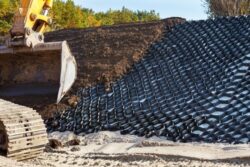The Different Types Of Erosion Control
 The Different Types Of Erosion Control
The Different Types Of Erosion Control
Erosion is the process of moving soil and other materials away from an area. It can have serious impacts on private and public properties, wildlife and waterways. There are a variety of erosion control methods that can be used to reduce these effects. In this blog, we will explore some of them and their benefits.
Stabilization
Soil stabilization is the process of minimizing erosion of soil by protecting exposed soil from wind and rain. It is important to prevent soil from eroding, as it can cause property damage, health hazards, and erosion-related sediment pollution. Stabilization includes temporary seeding, mulching, and a wide variety of other methods. Among the many benefits of stabilized areas are decreased sediment loss, reduced construction site costs, and enhanced landscape aesthetics. Temporary stabilization practices, such as temporary seeding and vegetated cover, are relatively inexpensive and easy to implement. They are most effective in addressing sediment losses (muddy runoff and dust) from construction sites and are less costly than sediment control measures, such as settling or filtering.
Vegetation
Vegetation is the collective term for plants and trees that grow in a particular area. Vegetation is an important component of the biosphere and has numerous functions, all at different spatial scales. Vegetation can protect a site from erosion by helping to maintain soil stability and reduce the speed at which soil erodes. Vegetation also binds the soil together and slows down runoff by increasing water infiltration. The vegetation that is best suited for slope stabilization depends on region and climate, but native grasses like foxtail, smooth brome, Timothy grass, and some wheatgrass varieties work well.
Drainage
Drainage is a type of erosion control that involves removing excess water from the surface of an area. It is used in a variety of ways to improve the quality of soil, regulate water flow and combat pollutants. There are several types of drainage systems, including surface and subsurface drainage. The main difference between these two is that surface drainage collects water on the ground surface while subsurface drains are installed under the top layer of soil to remove excess water. A surface drainage system can be arranged in various patterns, such as parallel drains and random drains. In most cases, parallel drains run parallel to one another in a single row. In some areas, parallel drains may be a better option than random drains. This is because the parallel system can provide uniform drainage to the entire field, whereas the random drains drain only the low areas in the field. When installing a surface drainage system, it is important to keep the soil at the correct slope and level. Ensure that the pipes are properly installed and buried at the proper depth.
Structural Repair
Structural repair is a type of erosion control that involves fixing weakened or damaged building structures. These structures can be foundations, walls, or roofs. Damaged or weakened buildings pose safety risks and can cause structural collapse. This is why it is important to carry out repairs and maintenance on these structures at regular intervals. When it comes to structural repairs, it is vital to appoint qualified erosion control contractors who have the necessary expertise and experience. This will ensure that the repairs are carried out in a way that is safe, effective and long-lasting!
Categorised in: Erosion Control
